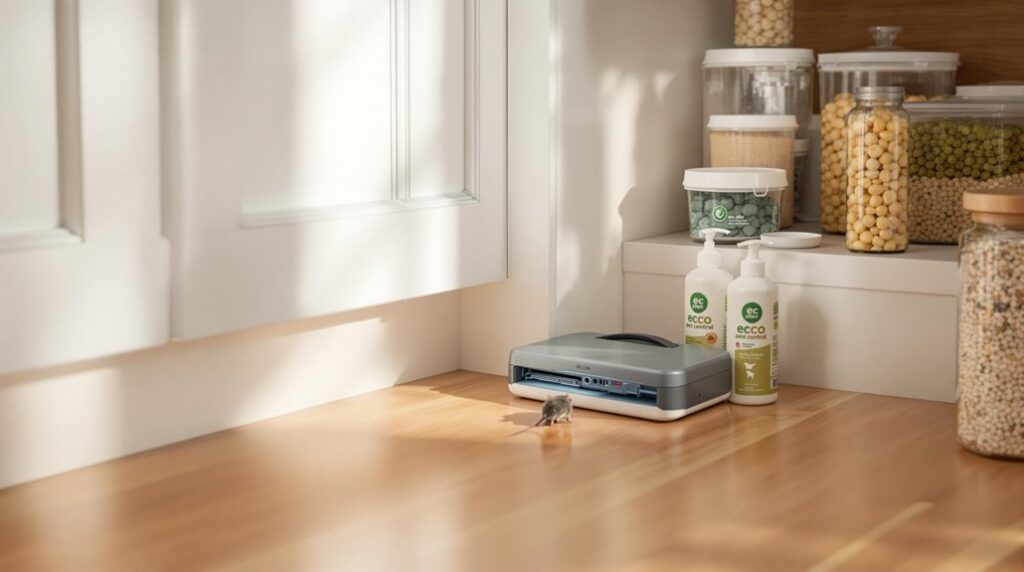I’ve dealt with countless mouse infestations across the UK, and I can tell you that most homeowners make the same critical mistakes when trying to eliminate these persistent pests. You might think you’re taking the right steps, but without understanding how mice actually behave and move through British homes, you’re likely wasting time and money on ineffective solutions. There’s a specific sequence of actions that actually works – and it’s probably not what you’d expect.
Key Takeaways
- Seal entry points with steel wool or aluminium mesh, as mice cannot chew through these materials.
- Use humane cage traps with peanut butter bait, checking twice daily and relocating mice 2+ miles away.
- Apply natural repellents like clove essential oil, white vinegar, or Fresh Cab monthly near entry points.
- Deploy 10-12 snap traps or bait stations per 100 square feet in high-activity zones for effective control.
- Conduct quarterly property inspections and annual professional assessments to prevent future infestations.
Understanding Mouse Infestation Patterns Across the UK
While most homeowners think mouse problems are random occurrences, understanding infestation patterns across the UK reveals predictable trends that can help you prevent and tackle these unwelcome guests.
I’ve noticed that urban centers like Greater London face the highest risk due to dense populations and abundant food sources. You’re likely to encounter more activity during winter months when mice seek warmth, and autumn peaks as they prepare for nesting. The COVID-19 lockdowns created a perfect storm—commercial closures displaced rodents into residential areas, causing a 120% spike in callouts during March-June 2020.
If you live in multi-dwelling buildings, infestations spread faster through shared walls and pipes. Construction sites nearby also create easy entry points into your home. Mice can squeeze through surprisingly small openings of just 6mm, making even tiny structural gaps a significant vulnerability for homeowners.
Sealing Entry Points and Essential Sanitation Measures
Once you’ve identified the infestation patterns in your area, your next priority should be blocking mice from entering your home and removing what attracts them in the first place.
I’ll show you the most effective sealing methods that actually work. Use steel wool or aluminium mesh to block entry points – mice can’t chew through these materials. After stuffing gaps with mesh, seal everything with exterior caulking and wood putty for a permanent barrier.
Your sanitation game needs to be strong too. Store all food in sealed containers and dispose of garbage regularly. These simple steps eliminate what draws mice inside.
Check your property monthly for new entry points or damage to existing seals. For large cracks, use cement to create a robust seal that prevents future mouse access. This proactive approach prevents re-infestation and keeps your home mouse-free long-term.
Natural Repellents That Actually Work

Natural repellents offer a chemical-free approach to mouse control that many homeowners prefer over harsh pesticides. I’ve found several natural methods that actually work when applied consistently.
Botanical repellent products like Fresh Cab contain balsam fir and lavender that create offensive odors to rodents. Place one pouch per 8 square feet and replace monthly for best results.
White vinegar’s acetic acid interferes with mice’s scent receptors. Soak rags or spray directly in affected areas, reapplying frequently as the smell fades. For optimal effectiveness, combine with barriers and other natural repellents rather than relying on vinegar alone.
Clove essential oil provides strong deterrent properties. Apply to cotton balls and place near entry points, renewing regularly to maintain potency.
Tabasco sauce mixed with water creates an irritating capsaicin barrier when sprayed around nests and pathways, though it requires frequent reapplication for continued effectiveness.
Humane Trapping Methods and Best Practices
Although traditional snap traps get the job done, humane trapping methods let you remove mice without harming them while still solving your infestation problem effectively.
I recommend cage traps with metal wire frames and clear lids for easy monitoring. Position them along walls where you’ve spotted mouse activity, focusing on kitchens and storage areas. Peanut butter works brilliantly as bait—secure it firmly to trigger mechanisms and replace every 24-48 hours.
Check traps twice daily to minimize stress on captured mice. When relocating, wear gloves and release them at least 2 miles away in woodland areas during daylight hours. This prevents their return while giving them the best survival chance.
Clean traps with mild detergent after each use and adjust placement if you’re not seeing results within 48 hours. Live traps can achieve a 90% success rate, making them highly effective for humane pest control.
Professional Pest Control Services and Costs
When DIY methods aren’t delivering results or you’re dealing with a severe infestation, professional pest control services offer thorough solutions that tackle the problem systematically. I’ll walk you through what you can expect from professional services.
Most reputable companies start with a detailed property survey to assess your infestation level and identify entry points. They’ll create a customized treatment plan using rodenticide bait stations, mechanical trapping, and exclusion techniques with steel wool or mesh. You’ll typically receive a 3-month guarantee with two follow-up visits and free retreatment if activity returns.
Costs vary based on property size, infestation severity, and location. Standard packages handle most situations, while premier services include thorough sanitization. Emergency callouts carry premium fees, but commercial contracts often offer negotiated long-term prevention rates. Professional services also provide post-infestation cleaning to restore proper hygiene standards after mouse removal is complete.
Council Support and Local Authority Options
Before investing in expensive professional services, you should explore what your local council offers for rodent control. Most councils provide pest control services at minimal cost – often just a small fee compared to private companies charging hundreds of pounds.
Your council has legal duties to keep public areas free from rats and mice, and they’ll intervene if your infestation threatens public health. They can even serve notices requiring you to take action, though they’re more focused on helping than penalizing residents.
Services vary greatly between councils, so I’d recommend calling yours directly to ask what’s available. Many offer treatments for common pests in private homes, especially if you’re in council housing or considered vulnerable. If you’re a tenant dealing with mice entering through structural issues, you may be able to pursue action against your landlord for failing to seal entry points. It’s worth checking before paying premium prices elsewhere.
Long-Term Prevention Strategies
Once you’ve dealt with an active mouse problem, preventing future infestations becomes your top priority. I’ll share the most effective long-term strategies that’ll keep your home mouse-free.
Start with thorough sealing – inspect your property for gaps as small as a dime and seal them with steel wool or caulk. Install door sweeps and cover larger holes with mesh.
Eliminate food sources by storing items in sealed containers and cleaning up crumbs immediately. Remove outdoor water sources and nesting materials like paper or fabric.
Deploy natural deterrents such as peppermint oil around entry points, or consider getting a cat as nature’s best mouse deterrent. Professional rodent-catching dogs can also effectively flush out any remaining hidden mice that standard methods might miss.
Conduct quarterly inspections to catch new gaps early, and don’t hesitate to schedule annual professional assessments for thorough protection.
Combining Multiple Control Methods for Maximum Effectiveness
While single control methods can tackle minor mouse problems, combining multiple approaches creates an unstoppable defense system that addresses every aspect of an infestation. I’ll show you how to layer these methods for maximum impact.
Start with the IPM framework—inspect, identify, then deploy coordinated strategies. I place snap traps near nesting sites while positioning bait stations along their foraging paths. This hits both immediate kills and delayed toxicity.
Here’s what works: Deploy 10-12 devices per 100 square feet in high-activity zones. Position traps perpendicular to walls with triggers facing baseboards. Rotate between snap traps, multi-catch systems, and electronic units every seven days to prevent behavioral adaptation.
Combine professional exclusion work with your DIY trapping efforts. Mice carry dangerous diseases like Hantavirus and Salmonella, making swift elimination critical to protect your family’s health and safety. This integrated approach guarantees you’re covering every angle.
Conclusion
I’ve shown you multiple proven methods to tackle mouse problems effectively. Don’t rely on just one approach—combine sealing entry points, maintaining cleanliness, using natural repellents, and setting humane traps for best results. If you’re dealing with a persistent infestation, don’t hesitate to contact professional pest controllers or your local council. Stay vigilant with regular inspections and remember that consistent prevention beats reactive measures every time. You’ve got the tools—now use them systematically.
References
- https://bpca.org.uk/write/MediaUploads/Documents/Research/Exec_summary_2013.pdf
- https://www.healthline.com/health/how-to-get-rid-of-mice
- https://pmc.ncbi.nlm.nih.gov/articles/PMC7071040/
- https://www.fantasticpestcontrol.co.uk/mice/how-to-get-rid-of-mice/
- https://straitsresearch.com/report/rodent-control-market/united-kingdom
- https://bugwisepestcontrol.co.uk/how-common-are-mice-in-uk-homes/
- https://pmpest.co.uk/how-to-get-rid-of-mice/
- https://www.aviva.com/newsroom/news-releases/2020/07/rodent-infestations-soar-in-uk-homes-during-lockdown/
- https://safeguardpestcontrol.co.uk/getting-rid-mice-mice-prevention/
- https://peststopboys.co.uk/blog/how-common-are-mice-in-homes-in-the-uk/

